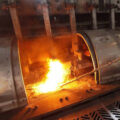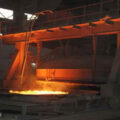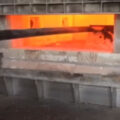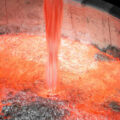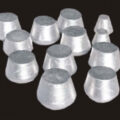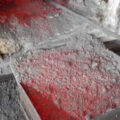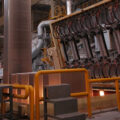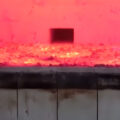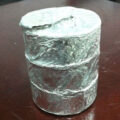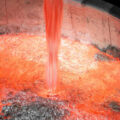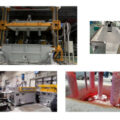Refining for aluminum alloy flat ingot:
(1) The proportioning ratio of electrolytic aluminum liquid should be controlled. The temperature of molten aluminum in the electrolytic cell is about 930 ℃. After being sucked out by vacuum ladle and transported to the foundry workshop, the temperature of molten aluminum remains at 860 ℃ ~ 900 ℃ , which belongs to superheated melt. In the actual production, the proportion of electrolytic aluminum liquid is controlled within 60%.
(2) As far as possible to achieve rapid melting and furnace refining for aluminum alloy. If the melting and refining time is long, the melt will overheat and coarse grains will be produced. Therefore, controlling melting and refining time is an important way to eliminate coarse grains.
(3) The charge consumption with coarse grain structure is controlled. The metal burden has the heredity of organization. It has been proved that in the process of 3104 alloy melting, the addition amount of charge with structure heredity should not exceed 15%.
(4) Casting process parameters control. In the DC casting of 3104 aluminum alloy flat ingot, it is necessary to control the coarse grains with higher cooling intensity on the premise of ensuring the good formability of the alloy flat ingot.
(5) Grain refiner was added. The addition of grain refiner should ensure the content of effective chemical elements and good solubility. Because the solubility of effective elements is good, the yield is high and the refining effect is good. The practice shows that the effect of grain refiner rods added to the chute is good.
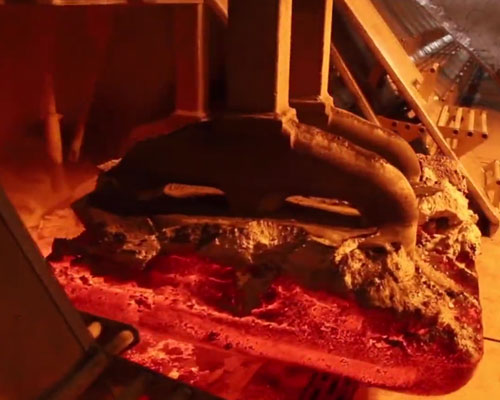
Inclusion defect control
(1) Strengthen charge management to prevent charge pollution.
(2) Do not use manual mixing or mechanical mixing as far as possible, but use electromagnetic stirring, permanent magnetic stirring or bottom permeable brick mixing to the greatest extent.
(3) Siphon device is used to transfer molten aluminum from vacuum ladle to smelting furnace, which reduces the possibility of oxide film formation in the process of aluminum melt transfer.
(4) Selecting the best solid-liquid ratio can reduce the adverse effect of electrolytic aluminum liquid with high impurity content on the formation of inclusions.
(5) Ensure the appropriate refining temperature for aluminum alloy and standing time, so that the inclusion has enough time to float up to the melt surface with the refining gas.
(6) The purity of refining gas should not be less than 99.90%.
(7) High quality double stage or composite filter plate is adopted.
Loose Defect Control
(1) Purification treatment of electrolytic aluminum liquid: the original aluminum liquid is transferred into the smelting furnace by siphon, then injected into the smelting furnace, proper amount of slag removal agent is added, electromagnetic stirring is conducted for 20-30 min, and the slag floating on the liquid surface is removed; the melt purification in the static furnace is appropriate to be refined with gas (CL, AR, n or the mixture of two gases). Three stage on-line degassing system is adopted for on-line purification, and 40 / 60 PPIceramic foam filter is suitable.

(2) Strictly control the standing time of melt in holding furnace: ensure that the melt standing time is not less than 30-40 min;
(3) Reduce the environmental humidity: set up an exhaust fan beside the casting platform side to eliminate the water vapor accumulated above the casting platform, so that the relative humidity of the production environment is less than 40%;
(4) Control the temperature of alloy liquid in the furnace: the temperature in the furnace can meet the process requirements (733 ~ 742 ℃).
Crack Control
(1) Under the condition of given chemical composition of 3104 alloy, by adjusting the content of Fe, Si and Fe / Si ratio within the range of composition, as much as possible A-phase and as little as possible β phase appear in the as cast 3104 aluminum alloy, and the cleavage of β phase relative to the alloy matrix is reduced.
(2) More effective grain refiners were selected to improve the size and morphology of the second phase in the alloy. At present, Al-5Ti-1B master alloy rod is usually used as grain refiner in the production of 3-Series aluminum alloy flat ingots. Although the refining effect is good, it has no obvious effect on the morphology and size of the second phase. Grain refiners was used to increase the wettability of carbon atoms and melt, increase the amount of TiC particles, provide more heterogeneous nucleation particles for the refining process, improve the surface activity of TiC particles, refine the grains, and make the iron rich phase appear short skeleton, small ball, short rod and particle, reduce the stress concentration caused by the morphology of the second phase, and reduce the over solidification of the alloy The tendency to produce hot cracks.
(3) According to the ingot specification, the appropriate cooling strength of ingot is selected, and the cooling water flow rate of large and small ingots is properly adjusted to eliminate the stress concentration caused by uneven cooling during solidification.


